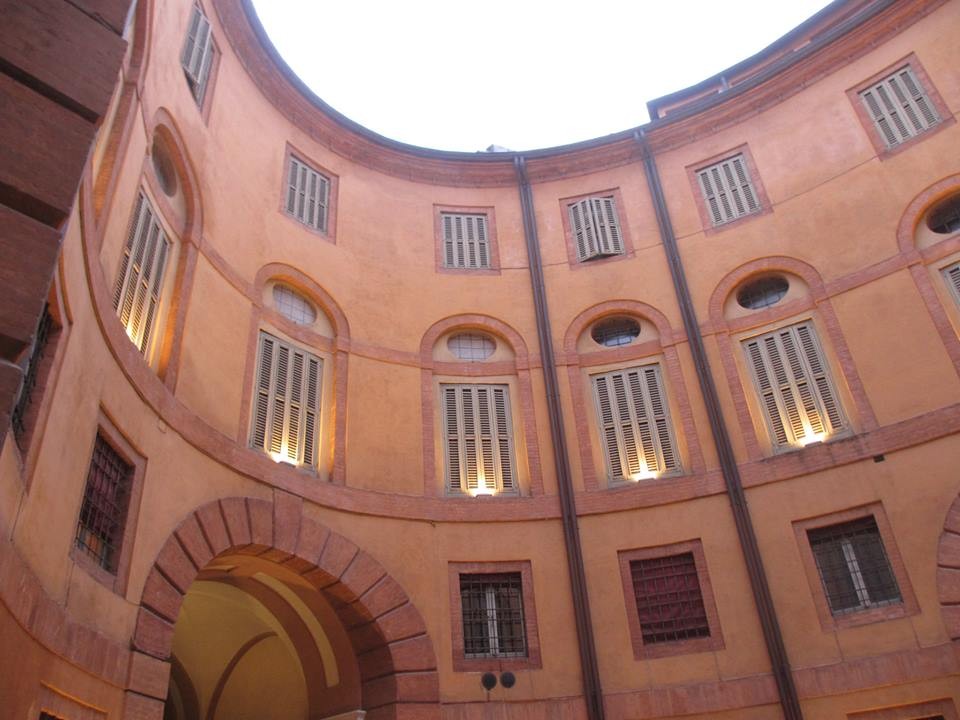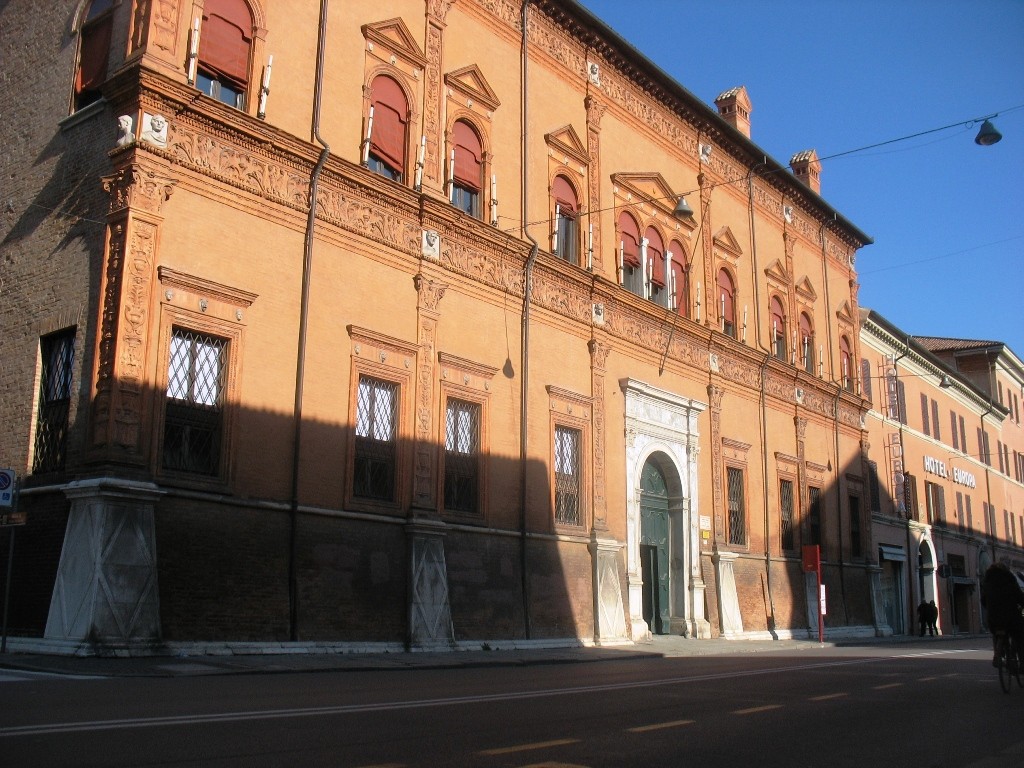The Renaissance area (1)
Going around the full perimeter of the castle, you will have the chance of appreciating him fully, though the best perspective is probably the one from Piazza Castello. Back where the plaque commemorating the massacre of the partigiani (people opposing the Fascist dictatorship) is placed, it will be a good idea to cross the road and walk for a few metres under the characteristic porch. Be careful not to miss a narrow passage on your right, which will lead you to a delicious small circular yard. The place is called Rotonda Foschini and it is the most suggestive parts of the theatre of Ferrara, as you will notice directing your gaze to the sky. The fascinating effect created by yard and the surmounting building, whose shape is actually elliptical, will arouse awe and dizziness at the same time! By the way, the theatre of Ferrara, built at the end of the 18th century, is one of the most important of Italy, and has housed in the past decades several important shows directed by the legendary director Claudio Abbado (who passed away less than one month ago).

Leaving the yard on the opposite side, you will be in Corso Giovecca, which has already appeared in a previous entry. In this case, though, by crossing this main artery you will be doing a symbolic act, to be explained by a quick incursion into the history of the city. At the beginning of the 15th century, indeed, the route composed by the current Corso Cavour and Corso Giovecca was the northern borderline of the city. It was the duke Ercole I d'Este who in 1492 entrusted the famous architect Biagio Rossetti with a plan of urban expansion, aiming to include into the urban fabric the area located north of the centre. In this way, a year which had already recorded an incredible series of events destined to pass into the annals of history was further enriched by the so-called Addizione Erculea (the above mentioned urban expansion). Taking this name from the duke who first conceived it, this urban plan was probably the first city plan ever realised in Europe. Its result, indeed, was a well-organised town, consisting in the southern medieval area and the northern district, mainly developed during the Renaissance. Corso Cavour and Corso Giovecca corresponded exactly to the line of demarcation between the two areas.

Once on the other side of Corso Giovecca, then, you will take a few steps on the right, reaching the remarkable Palazzo Roverella. Built at beginning of the 16th century, it has been over the centuries the abode of the homonymous noble family. Its most interesting feature is doubtlessly the brick facade, adorned by a series of geometrical decorations. Turning left into Via Boldini, in a few metres you will reach the delicious Piazzetta Sant'Anna. Dating back to the 15th century, this small square was originally the courtyard of the ancient hospital of Sant'Anna. The fine colonnade found on one side of the square originally belong to an Armenian monastery. Going on along via Boldini, you will finally turn left into Via Previati, following it until reaching a wider space, namely Piazza Tasso. Overlooking the square, the church called Chiesa del Gesù preserves a few interesting paintings. Crossing the square, you will then end up in one of the most fascinating streets in Ferrara, marking the real beginning of your route through the Addizione Erculea.

Via Ercole I d'Este, indeed, was the strategic axis of the city plan designed by Biagio Rossetti. Formerly known as Via degli Angeli, it originally connected the Castle to the church of Santa Maria degli Angeli (now not existing any more). Its paving consists in characteristic cobble stones, flanked by two series of equally distinguishing milestones. As you will discover walking along it, on the two sides of the streets neither stores nor common buildings are found, but rather elegant palaces and gardens instead. Casting a last look to the Castle on your right, you will then set out to discover this charming street, which is made even more unique by the almost complete absence of cars. Indeed, walking along via Ercole I d'Este is a bit like undertaking a journey to the past centuries, as the sounds of the town and the noisy crowds will apparently fade away, at least for a few minutes. Among the fine buildings located on the right side of the street, the most remarkable is probably Palazzo di Giulio d'Este, currently houses the Prefecture of Ferrara. Taking is name from one of the sons of Ercole I d'Este (who was even imprisoned in the Castle after taking part in a conspiracy against his brother), the palace was probably designed by Biagio Rossetti.
Photo gallery
Content available in other languages
- Italiano: L'area del Rinascimento (1)
- Português: A área do Renascimento (1)
- Español: La zona del renacimiento - parte 1
Want to have your own Erasmus blog?
If you are experiencing living abroad, you're an avid traveller or want to promote the city where you live... create your own blog and share your adventures!
I want to create my Erasmus blog! →


















Comments (0 comments)